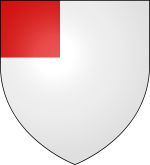Canton (heraldry)

Canton is a square charge placed in the upper dexter corner. It is classed by some heraldic writers as one of the honorable ordinaries; but, strictly speaking, it is a diminutive of the Quarter, being two-thirds the area of that ordinary.[1] However, in the roll of Henry III the quarter appears in several coats which in later rolls are blazoned as cantons. The canton, like the quarter, appears in early armory, and is always shown with straight lines.
A canton sinister is a canton placed on the sinister side of the shield.
The chequer, a pane of the field of chequy, can be considered a diminutive of the canton, though it cannot be a charge on its own.
An "enlarged sinister canton" appears in the arms of William Wilde Lotter.[2][3]
A plain, uncharged canton (sometimes a canton voided is also used this way) can be used as a mark of distinction, that is, not a mark of peculiar honour, but a mark denoting that the bearer is a stranger in blood.[citation needed] For example, a groom, not descended from the bride's family, adopting the bride's last name after the marriage, might upon receipt of a Royal Licence permitting this, use the bride's family's coat of arms with an uncharged canton or canton voided.[citation needed]
See also
References
- ^ Chisholm, Hugh, ed. (1911). . Encyclopædia Britannica (11th ed.). Cambridge University Press.
- ^ ""South African Bureau of Heraldry: Application for Registration of Heraldic Representations and Objections Thereto, 10 November 2006". Retrieved 2010-09-19.
- ^ ""South African Bureau of Heraldry: Registration of Heraldic Representations, 27 July 2007"". Retrieved 2010-09-19.
